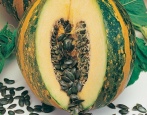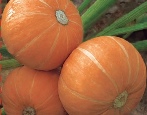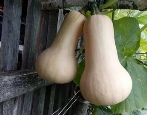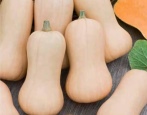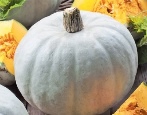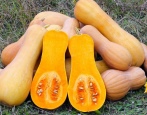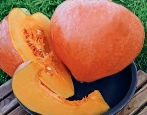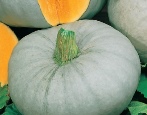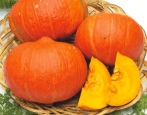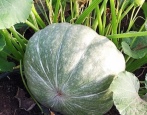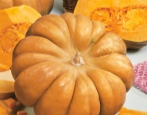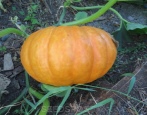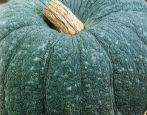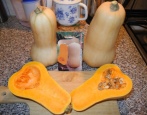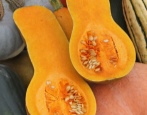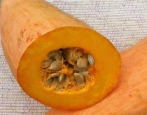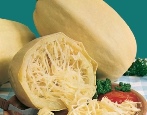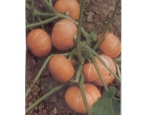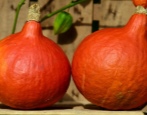
- The form: round cylindrical
- Coloration: yellow with wide dark green, spotted stripes
- Bark: thin, hard
- Color of the pulp: light yellow
- Pulp (consistency): low-fiber
- Ripening terms: mid-early
- Appointment: for fresh consumption, for home cooking, for juicing
- Fruit surface: slightly ribbed
- Sowing time in the ground: in May-June
- Sowing scheme: 100x70 cm
Breeders bred the type of gymnosperm pumpkin for easier extraction of oil from plant seeds. Apricot pumpkin is one of the universal types and wins the hearts of gardeners with its taste.
Description of the variety
Pumpkin Apricot belongs to melons and gourds annual vegetables. It belongs to the genus of herbaceous plants of the pumpkin family. Apricot pumpkin is grown for food, less often for feed use. This pumpkin variety has the advantage of having a large amount of oil in its seeds, which do not have a tough shell.
Characteristics of the appearance of plants and fruits
Apricot pumpkin is almost identical in characteristics with pumpkins of nutmeg and large-fruited varieties. Biological characteristics of pumpkin:
the color of the bark is yellow with wide green, irregular stripes;
shoots of a long-leaved bush reach 6-8 meters in length, so they should be tied to a support;
the stem is hollow, 1 cm in diameter, has branched antennae;
leaves are large, having a lobed appearance of green color with a weak dissection;
roots are powerful, branched, going into the ground for 2 meters;
pumpkin fruits with a hard thin bark, weighing up to 6-7 kilograms, have a rounded shape with ribbing;
the seeds are flattened, lacking protein, medium in size, without a shell, oily;
the edible pulp is slightly fibrous, reaching 5-7 cm in thickness.
Purpose and taste
This variety has a beige or light yellow pulp with a pronounced apricot flavor. There is a sweet aftertaste after eating dishes made from this pumpkin.
Pumpkin Apricot is grown for its seed oil. This pumpkin belongs to dessert varieties and is widely used in cooking both fresh and after thermal treatments. Juices, mashed potatoes, vegetable side dishes, salads are prepared from it. They are also used to decorate main dishes. Ground seeds are used in sauces, homemade baked goods, give dishes an original taste and pleasant aroma.
The seeds of this variety are used in folk medicine:
to strengthen the cardiovascular system, since they contain vitamin K and magnesium;
to preserve youth due to the high content of tocopherols (vitamins A, E);
for the rapid regeneration of liver tissue due to niacin;
as an antifungal, antiviral agent, as it contains vitamins B, B2, C, T.
Ripening terms
Apricot pumpkin belongs to the mid-early varieties in terms of ripening. The period of full ripening occurs 90-100 days after planting from the emergence of shoots. As it ripens, the color of the Apricot pumpkin changes. The young fruit has a dark green color, and by the time of ripening, the pumpkin turns orange, green stripes appear on it. The wider the strip, the closer the fruit is to ripening.
Yield
Possessing a large number of advantages, the Apricot pumpkin does not differ in high productivity. The bush of the plant has a climbing appearance with multi-nested ovaries. The plant is monoecious, pollinated by bees.For high-quality pollination, honey-type plants, grasses or shrubs should be planted next to the pumpkin. This allows you to increase the yield of the plant up to 5 fruits per bush.
In the north and in regions with a temperate climate, pinch the ovaries, leaving no more than three on one plant. Thus, they achieve enlargement of fruits, which reach 8 kg in weight.
The southern regions have a lot of sun and a hot climate, which has a positive effect on yields. Therefore, in such places all the formed ovaries are left on the plant. When ripe, the fruit reaches 10-14 kg.
Growing regions
Apricot pumpkin is very popular among gardeners for its unpretentiousness and the ability to grow in different temperature conditions. Recommended for cultivation in the southern regions and the middle lane. However, the best yield of this crop is observed:
on the Black Sea coast;
in the Urals;
in Eastern Siberia;
in Central Asia;
in outskirts of Moscow.
Growing and care
The high yield of Apricot pumpkin depends directly on the climate in which it grows, since the plant is very warm and light-loving. The landing site should be selected open, well-lit, windless, located on the south side.
Sowing seeds is carried out after the establishment of dry, warm weather, so as not to risk the plant in case of sudden frosts. Cultivation is carried out more often by seedlings, less often by sowing in open ground, since seeds without a shell are prone to rotting. In any of the ways, planting rules should be followed.
Seeds:
sown at a temperature of 12-15 ° C at the end of May at a distance of 60 cm from each other;
before planting, heat treatment of seeds is carried out, warming them up at a temperature of + 40 ° C for 8-10 hours;
soaked in root-forming solutions for 12 hours, for example, in "Kornevin";
prepare holes 60 cm wide, 20 cm deep;
fertilize the holes with potassium or phosphate solutions, humus;
pour 2 liters of water at room temperature into each, then lower the seeds and cover with earth.
Seedlings:
sowing is carried out in late May - early June in glasses with peat, since the plant does not tolerate a pick poorly;
the seeds are washed before sowing, disinfected in potassium permanganate;
until sprouts appear, the seeds are covered with a film, maintaining a temperature of 15-25 ° C;
watering is carried out weekly;
seedlings emerge after 14 days, after which they are planted in open ground, it is important that the outside temperature does not drop below 15 ° C.
You cannot plant Apricot pumpkin on an area where carrots, cucumbers or tomatoes were previously planted, since these crops take most of the minerals from the ground. Watering should be done once every 7 days in dry weather, in rainy weather - once every 14 days. Regularly, you need to carry out treatment with antifungal drugs, and regular treatment with potassium-phosphorus and nitrogen fertilizers. And you should also mulch the plant to keep the soil moist.
Disease and pest resistance
When breeding this variety, breeders have created some abilities:
resistance to waterlogging;
endurance of low temperatures down to -5 ° С;
resistance to anthracnose and bacteriosis.
The plant can be susceptible to some diseases.
Powdery mildew. In this disease, all affected areas of the plant should be removed and treated with a solution of colloidal sulfur or Bordeaux liquid.
Peronosporosis. Having found this disease, you need to remove the affected leaves, treat with a solution of copper oxychloride or Bordeaux liquid.
The plant is susceptible to attacks by some pests.
Melon aphid. If detected, spray with soap or alkaline solution.
Spider mite. If signs of the disease are noticed, the plant should be treated with Aktarofit.
The Apricot Pumpkin variety requires attention and physical costs when growing. However, the beneficial properties and pleasant taste attract more and more fans of this variety.
